Table of Contents
- The Digital Adoption Crisis: Why Traditional Approaches Fall Short
- AI as the Catalyst for Digital Adoption Transformation
- The Five Pillars of AI-Driven Digital Adoption Strategy
- The CTO’s Roadmap to AI-Powered Digital Adoption
- Overcoming Common Challenges in AI-Driven Digital Adoption
- Future-Proofing Your Enterprise with Apty’s AI-Powered Digital Adoption Platform
- Conclusion: The Competitive Advantage of AI-Driven Digital Adoption
AI & Digital Adoption: A CTO’s Guide to Building a Future-Proof Enterprise
Did you know that your employees waste a staggering 36 working days each year struggling with technology frustrations? Or that large enterprises lose approximately $104 million annually due to digital inefficiencies? Perhaps most shocking is the 1,600% gap between the perceived and actual number of enterprise applications in use.
These aren’t just alarming statistics—they represent the silent crisis undermining your digital transformation efforts. While organizations continue to invest billions in cutting-edge software, the fundamental disconnect between implementation and adoption threatens to render these investments nearly worthless.
For CTOs and technology leaders, this represents a critical inflection point. As enterprises expand their tech stacks, with the average organization now managing 172 AI-powered applications, the need for strategic, AI-driven digital adoption has never been more urgent.
This guide explores how forward-thinking CTOs can leverage artificial intelligence to transform digital adoption strategies, reduce IT strain, align transformation with business ROI, and ultimately build enterprises that are not just digitally enabled but genuinely future-proof—empowered by AI Voicebots for automating routine calls.
The Digital Adoption Crisis: Why Traditional Approaches Fall Short
The digital workplace has fundamentally changed. Employees now navigate complex ecosystems where completing a single task often requires interaction with more than 10 different applications. This growing complexity has increased the demand for AI voice agents, which streamline workflows by enabling employees to perform actions hands-free and reduce the friction of switching between multiple tools.
Traditional software training—typically delivered as one-time sessions during implementation—simply cannot adequately prepare users for this level of complexity. In fact, 33% of employees report receiving an hour or less of training when introduced to new software, while 78% acknowledge lacking expertise in the tools they use daily.
This gap between implementation and adoption creates cascading problems:
- Wasted investments: Organizations utilize only 40-60% of their software’s available functionality, according to Forrester Research.
- Productivity drain: Employees lose 26% of their productivity due to application overload and fractured software experiences.
- Data quality issues: Poor adoption leads to inconsistent data entry, compromising the integrity of business intelligence.
- Support burden: IT departments face overwhelming ticket volumes for basic software usage questions.
- Change resistance: Failed adoption experiences create organizational resistance to future digital initiatives.
Traditional approaches to digital adoption—centered on classroom training, static documentation, and reactive support—were designed for a simpler technological era. Today’s enterprise software environment demands a fundamentally different approach, one that can scale across hundreds of applications and adapt to constantly evolving interfaces and workflows.
Want to know what digital adoption really means and why it matters for your enterprise?
👉 Read more: What is Digital Adoption and Why is it Important?
AI as the Catalyst for Digital Adoption Transformation
Artificial intelligence is revolutionizing how organizations approach digital adoption, transforming it from a static, training-centered activity to a dynamic, intelligent process that adapts to user needs in real-time. This shift represents a fundamental change in how enterprises support their technology investments.
The most significant AI-driven transformations in digital adoption include:
- Predictive assistance: Advanced ML algorithms can now predict user behaviors and preemptively solve problems before they occur, redefining the learning experience.
- Contextual guidance: AI-powered platforms deliver personalized support at the exact moment of need, eliminating the “forgetting curve” that plagues traditional training.
- Process intelligence: AI analytics identify adoption bottlenecks and process inefficiencies across applications, enabling targeted interventions.
- Automated content creation: GenAI capabilities dramatically reduce the time and cost of creating adoption content, with some organizations reporting 90% reductions in content development time.
- Cross-application intelligence: AI now enables seamless guidance across multiple applications, supporting complex workflows that span different systems.
The impact of these capabilities is substantial. Elite digital adopters—representing just 7% of enterprises—are setting new standards for AI integration and digital transformation success. They achieve 85% ROI on digital projects, drive 90% AI adoption among employees, and are 40% more likely to reach a state of Hyper Productivity compared to their peers.
The Five Pillars of AI-Driven Digital Adoption Strategy
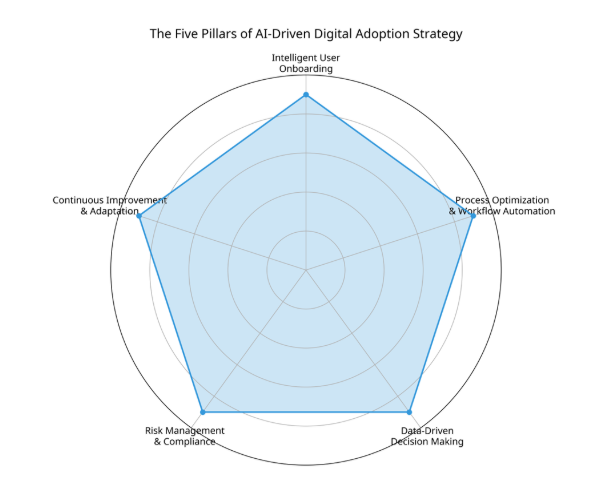
For CTOs seeking to harness AI’s transformative potential for digital adoption, five strategic pillars provide a comprehensive framework:
1. Intelligent User Onboarding and Training
AI-driven digital adoption platforms have transformed onboarding from a one-time event to a continuous, personalized journey. These platforms create tailored learning paths based on user roles, skill levels, and specific objectives.
According to Fantasy AI, more than 1.1 billion people are expected to use AI for learning by 2031, reflecting how intelligent, adaptive systems are rapidly shaping modern learning experiences. Unlike traditional training that follows a one-size-fits-all approach, AI-powered systems adapt in real-time to user behavior.
Key capabilities include:
- Personalized guidance that appears exactly when users need assistance
- Multi-format learning content that adapts to individual learning preferences
- Automated skill assessment that identifies knowledge gaps
- Contextual tooltips and walkthroughs that guide users through complex processes
This approach reduces onboarding time by up to 50% while dramatically improving knowledge retention and application.
Want to know how Apty can help streamline your Learning & Training Development initiatives?
2. Process Optimization and Workflow Automation
AI excels at identifying inefficiencies in how employees interact with software. By analyzing user journeys across applications, AI-powered adoption platforms can:
- Identify bottlenecks where users consistently struggle
- Recommend workflow optimizations based on usage patterns
- Automate repetitive tasks that create friction
- Create cross-application guidance for complex business processes
McKinsey’s research confirms that redesigning workflows has the biggest effect on an organization’s ability to see EBIT impact from its use of generative AI, with organizations that fundamentally redesign workflows seeing significantly higher returns on their AI investments.
3. Data-Driven Decision Making
The most sophisticated digital adoption strategies leverage comprehensive analytics to continuously improve. AI-powered platforms provide unprecedented visibility into:
- User engagement metrics across all content types
- Step-level performance analysis for every workflow
- Adoption trends by department, role, and individual
- Software utilization patterns and license optimization opportunities
These insights enable CTOs to make data-driven decisions about technology investments, training priorities, and process improvements. Organizations that track well-defined KPIs for their AI solutions report substantially higher bottom-line impact than those that don’t.
4. Risk Management and Compliance
As enterprises deploy more AI-powered applications, managing associated risks becomes increasingly important. Leading organizations are actively addressing:
- Data quality through enhanced validation at the point of entry
- Compliance with regulatory requirements through guided workflows
- Cybersecurity risks can be mitigated through proper user training and permissions
- Intellectual property concerns through appropriate AI governance
According to McKinsey, organizations are increasingly managing risks related to AI inaccuracy, cybersecurity, and IP infringement, with larger organizations leading the way in implementing comprehensive risk management strategies.
5. Continuous Improvement and Adaptation
The most successful digital adoption strategies embrace an iterative approach, using AI to:
- Gather continuous feedback on user experiences
- Identify emerging training needs as software evolves
- Adapt guidance based on changing business requirements
- Optimize content based on engagement analytics
This creates a virtuous cycle where adoption continuously improves over time, rather than degrading as software and processes change.
The CTO’s Roadmap to AI-Powered Digital Adoption
Implementing an AI-driven digital adoption strategy requires a structured approach, supported by custom AI development that ensures your adoption tools and automation are purpose-built for your enterprise environment. Here’s a practical roadmap for CTOs:
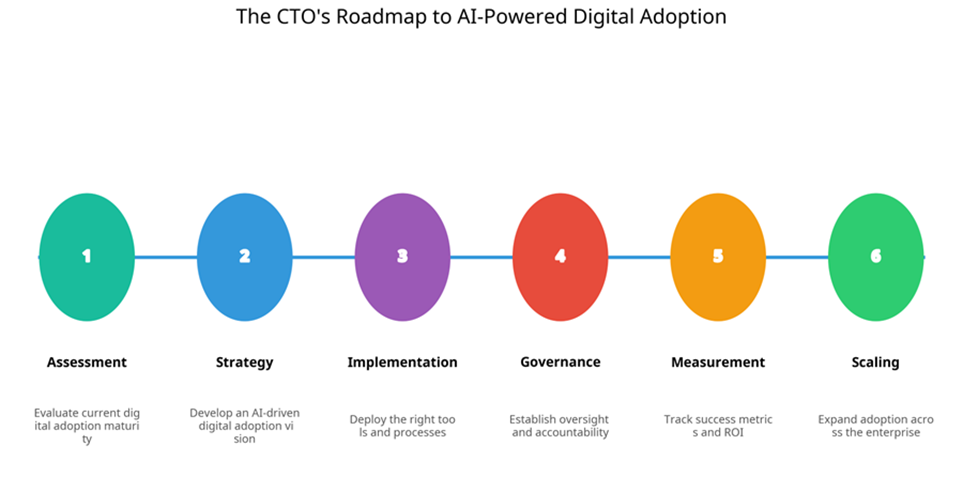
Assessment Phase
Begin by evaluating your organization’s current digital adoption maturity:
- Audit existing software utilization and adoption rates
- Identify critical applications with the highest impact on business outcomes
- Assess current training and support mechanisms
- Benchmark against industry standards and best practices
Strategy Development
Create a comprehensive digital adoption vision aligned with business objectives:
- Define clear goals and success metrics for your digital adoption initiative
- Identify key stakeholders and secure executive sponsorship
- Develop a business case with projected ROI
- Create a phased implementation plan with clear milestones
Implementation
Deploy the right tools and processes to support your strategy:
- Select an AI-powered digital adoption platform that aligns with your needs
- Integrate with existing systems and data sources
- Develop initial content and workflows for high-priority applications
- Pilot with select user groups before broader rollout
Governance
Establish oversight and accountability mechanisms:
- Assign clear ownership for AI governance (28% of organizations have their CEO responsible for this)
- Create policies for content creation, review, and maintenance
- Develop risk management protocols for AI-generated content
- Establish data privacy and security guidelines
Measurement
Implement robust tracking of success metrics:
- Define KPIs aligned with business outcomes
- Create dashboards for real-time visibility into adoption metrics
- Establish regular review cycles to assess progress
- Develop an ROI calculation methodology
Scaling
Expand adoption across the enterprise:
- Develop a center of excellence to support broader implementation
- Create standardized templates and best practices
- Implement train-the-trainer programs to build internal capability
- Continuously expand to additional applications and workflows
Overcoming Common Challenges in AI-Driven Digital Adoption
While the benefits of AI-powered digital adoption are compelling, CTOs should be prepared to address several common challenges:
Resistance to change: Even the most sophisticated AI solutions require user acceptance. Successful implementations focus on change management, clearly communicating benefits, and involving users in the design process.
Data privacy and security concerns: As AI systems analyze user behavior, organizations must implement robust data governance to maintain trust and compliance. This includes transparent policies about what data is collected and how it’s used, supported by strong AI Security Posture Management practices.
Balancing automation with human oversight: While AI can automate many aspects of digital adoption, human oversight remains essential. Organizations should establish clear review processes, with 27% of organizations reviewing all AI-generated content before use.
Ensuring inclusivity: Digital adoption solutions must accommodate diverse user needs, including different learning styles, technical proficiency levels, and accessibility requirements. The most effective platforms offer multiple formats and approaches.
Maintaining the human element: As processes become more automated, preserving human connection becomes increasingly important. The most successful implementations use AI to enhance human capabilities rather than replace them.
Future-Proofing Your Enterprise with Apty’s AI-Powered Digital Adoption Platform
Apty stands at the forefront of AI-driven digital adoption, offering a comprehensive platform designed to address the challenges outlined in this guide. Apty’s solution is built on a foundation of advanced AI capabilities that transform how organizations approach software adoption.
Key Features of Apty’s AI-Driven Platform
Apty OneX: A unified Digital Adoption Platform powered by GenAI that enables users to interact and transact across various enterprise applications from a single interface. This revolutionary approach features conversational UI for executing day-to-day tasks and AI that helps auto-fill forms without switching applications.
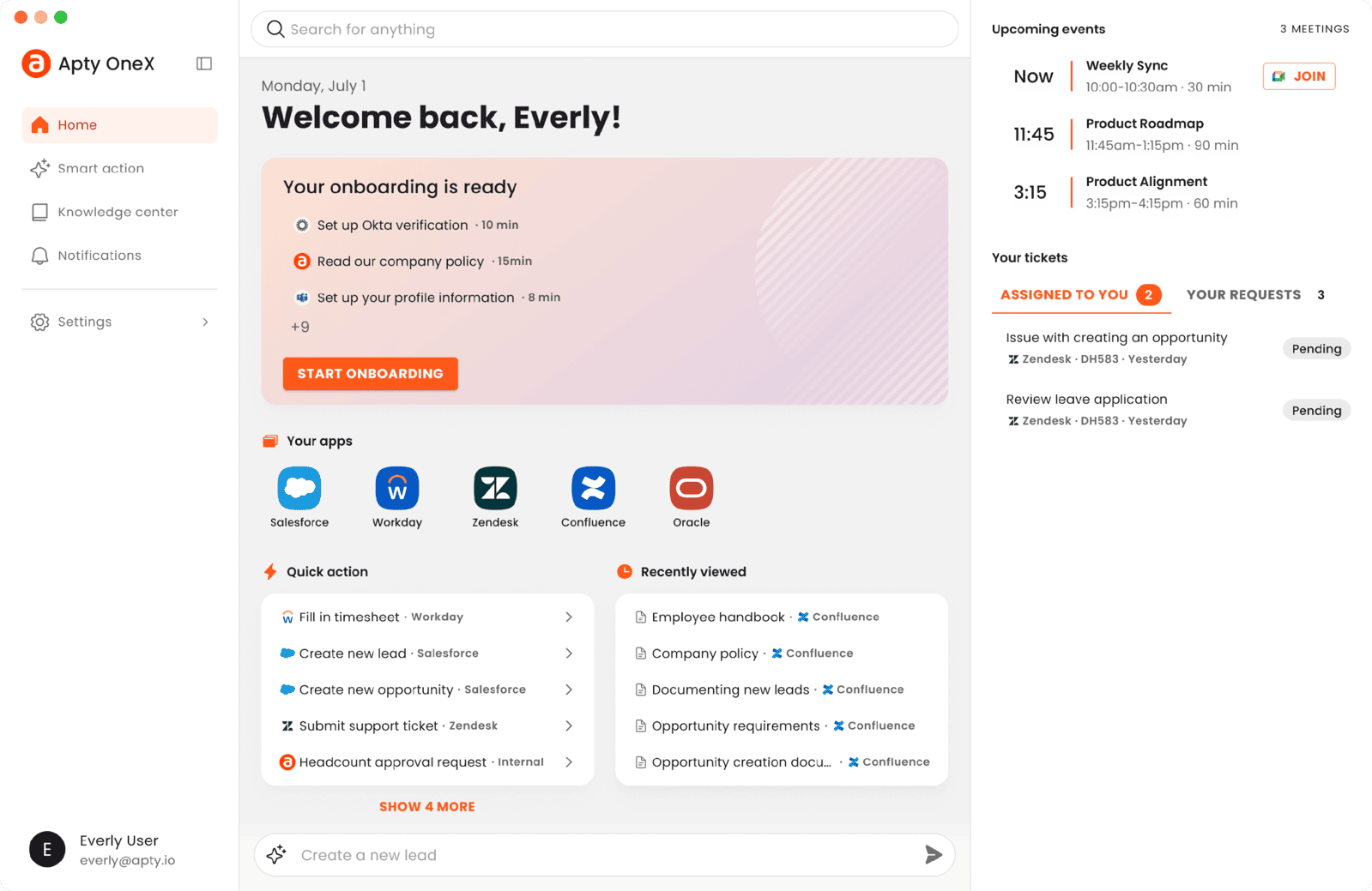
Apty Pulse™: This powerful analytics tool helps organizations identify unused and underutilized software, visualize user flows across key business processes, and generate AI-powered prescriptions for improving adoption.
Enhanced Content Creation Experience
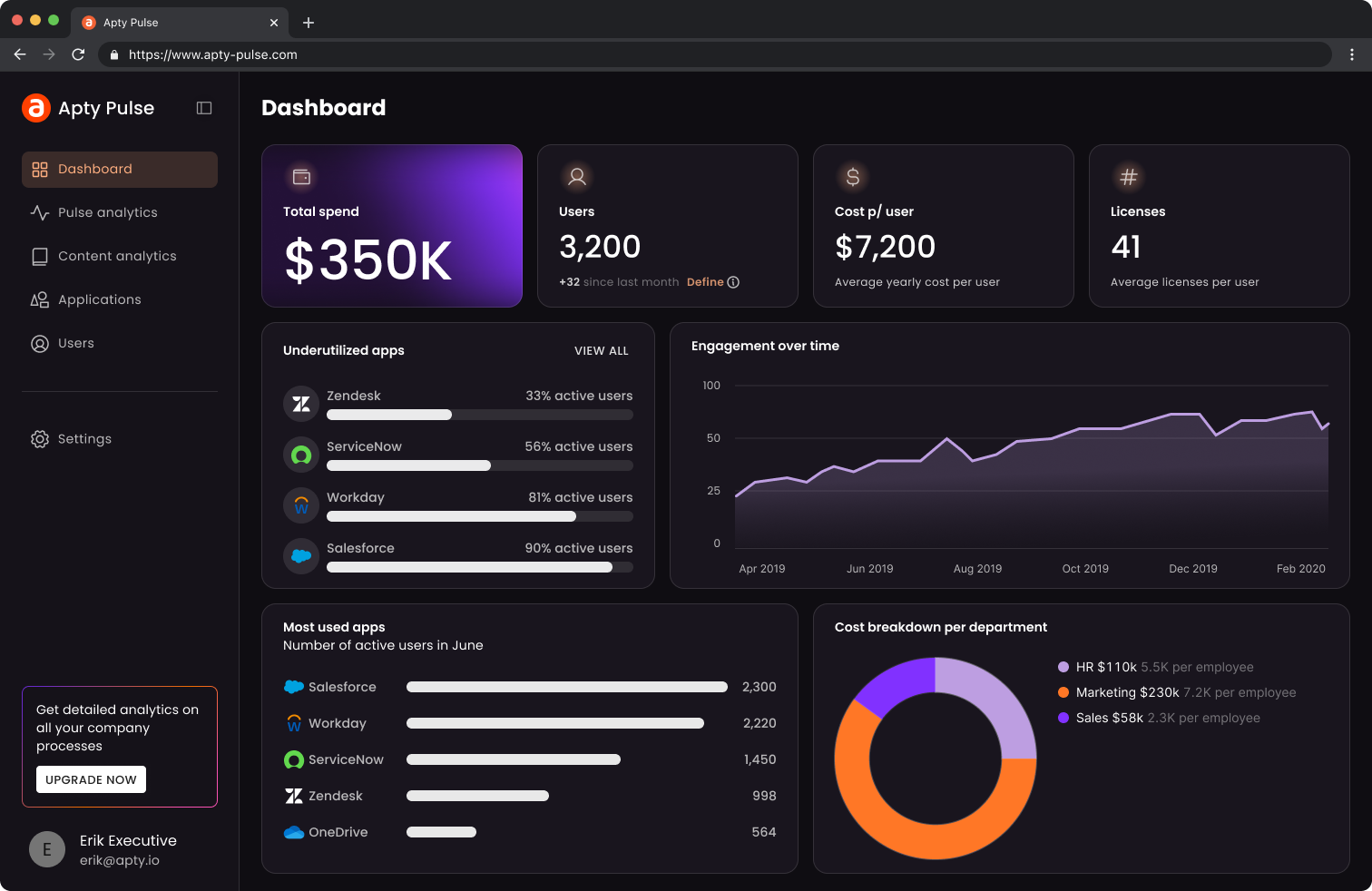
Apty’s AI-powered content creation tools enable organizations to reduce content development time by 90% while achieving 5X cost savings. The platform’s record workflows feature allows content creators and SMEs to build adoption content with minimal technical skills.
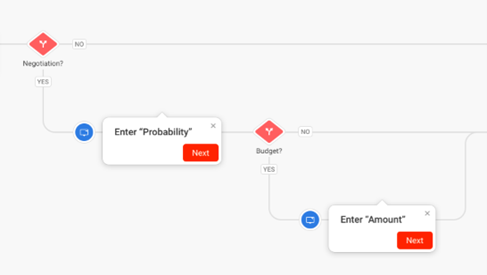
Advanced Content Analytics: Apty provides comprehensive analytics across all content types, with detailed insights into user behavior, engagement trends, and step-level performance for every workflow. This enables data-driven decision-making about adoption strategies.
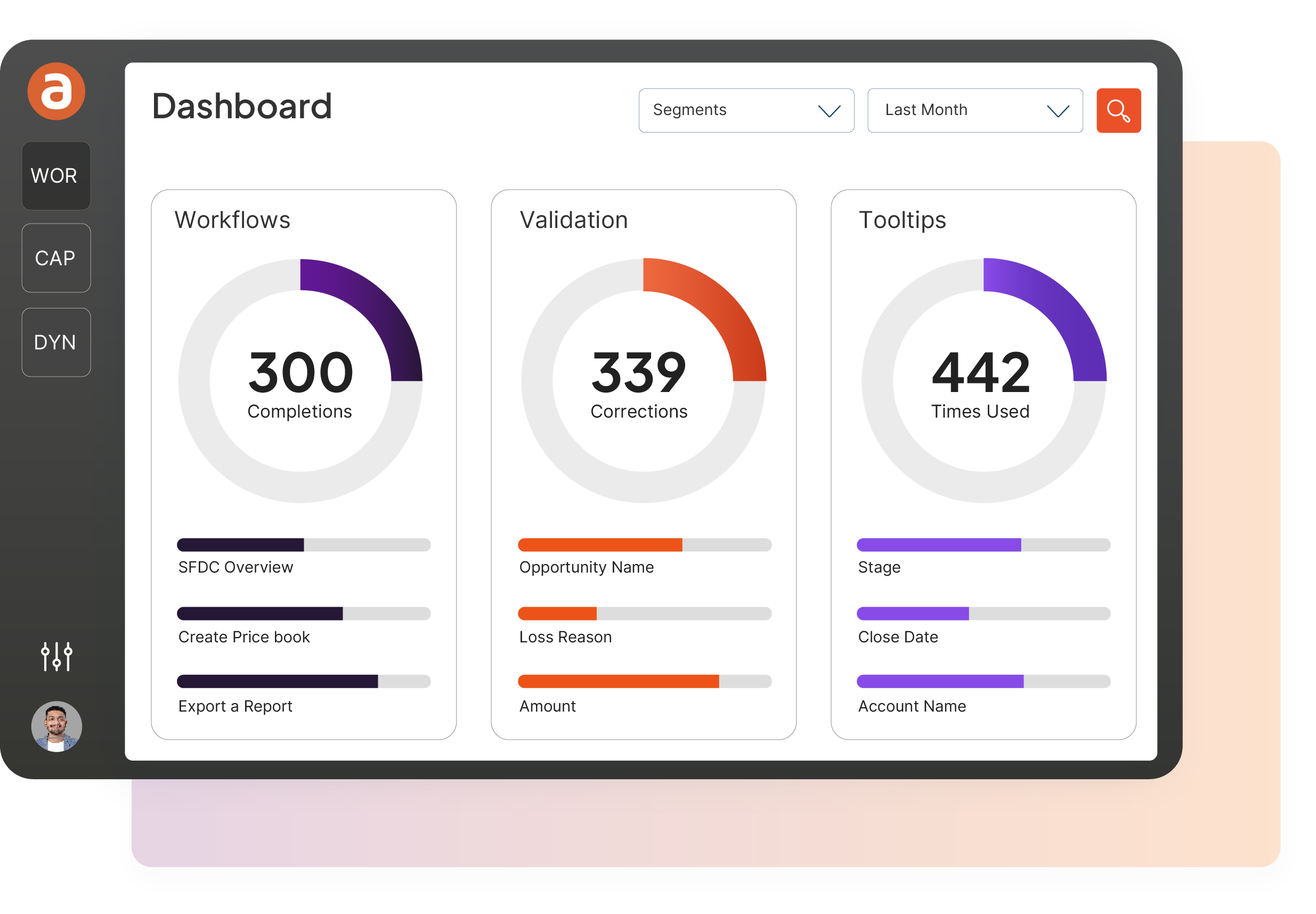

Smart Rule Engine: Apty’s intelligent rules engine enables conditional display of content based on user actions, auto-triggering of workflows based on user segments or errors, and dynamic workflow branching for complex processes.
Real-World Impact
Organizations implementing Apty’s AI-powered digital adoption platform report significant business outcomes:
- 50% faster onboarding for new employees
- 30% fewer process errors
- 25% reduction in support tickets
- Improved data quality and process standardization
- Accelerated digital transformation initiatives
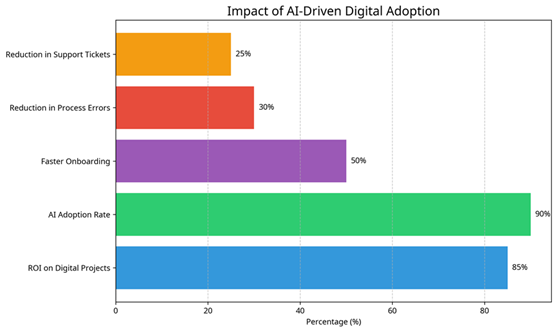
By addressing the full spectrum of digital adoption challenges—from user onboarding to process optimization to analytics—Apty enables CTOs to maximize the return on their software investments while building truly future-proof enterprises.
Conclusion: The Competitive Advantage of AI-Driven Digital Adoption
As enterprises continue to invest in digital transformation, the gap between leaders and laggards will increasingly be defined not by which technologies they implement but by how effectively their people adopt and utilize those technologies. AI-driven digital adoption represents a strategic imperative for CTOs who seek to maximize ROI, enhance productivity, and build organizations capable of continuous adaptation.
The statistics are clear: elite digital adopters achieve 85% ROI on digital projects and drive 90% AI adoption among employees. They leverage AI not just as another technology to implement, but as a fundamental catalyst for reimagining how humans and technology work together.
For CTOs, the message is clear: future-proof your enterprise by making AI-driven digital adoption a cornerstone of your technology strategy. The alternative – continuing with traditional approaches to software implementation and training.
The time to act is now. Assess your current digital adoption maturity, explore AI-powered solutions like Apty, and begin the journey toward building an enterprise where technology truly delivers on its transformative promise.
Get in touch with our experts to book a free demo today!
